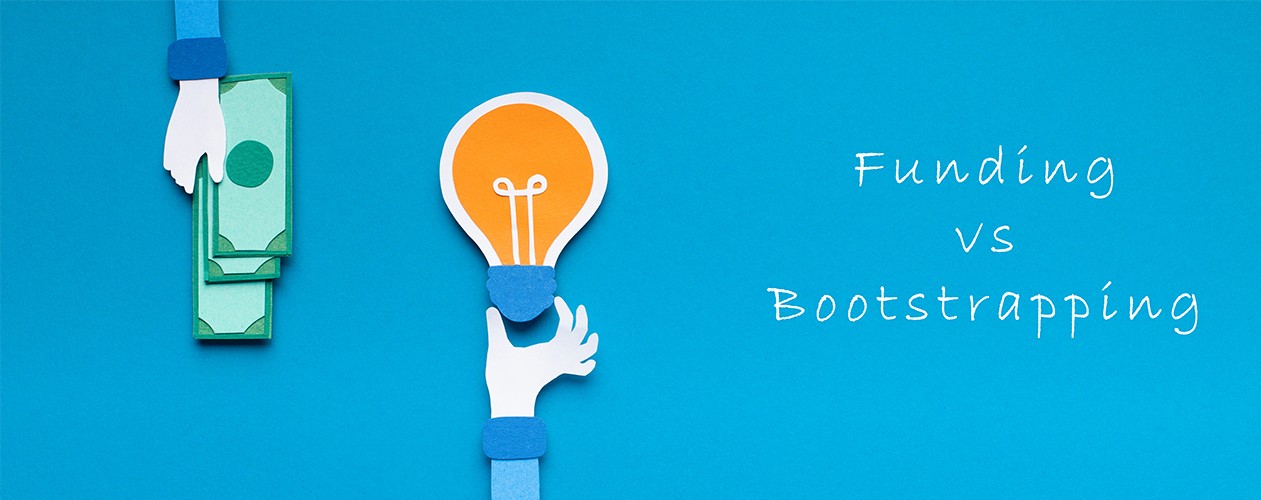Introduction
“I really need some funds for my business.”
“Shall I go for fundraising? Or bootstrap instead?”
These questions regarding funding have kept entrepreneurs perplexed for some time now. Undoubtedly it seems very tough to take these crucial strategic decisions.
While the internet is flooding with a multitude of notions supporting one over the other, we recommend a deep understanding of the nature of your business, its current requirements, and the advantages and disadvantages of both fundraising and bootstrapping to decide which suits you the best.
So first, let’s understand what these terms mean.
Bootstrapping vs Fundraising: Overview
Bootstrapping is when you start and grow a business using personal savings, revenue generated from the business, and any other available resources without seeking external funding. This approach is typically adopted by entrepreneurs who want to retain complete control of their business and avoid the pressure of meeting investors’ expectations.
On the other hand, fundraising involves seeking external funding from investors, venture capitalists, or other sources to finance business operations and growth. In exchange for the investment, the investors usually get a share of the company’s equity or profits.
But which one is best for you?
To decide that entrepreneurs need to delve deep into the nature of their business and its current and future requirements. Considering the following factors can aid this decision-making to a great extent.
Bootstrapping vs Fundraising: Decisive Factors
Business Goals:
Entrepreneurs need to consider their long-term business goals before deciding which approach to take. For example, if your long term goal permits you to grow your business in a lean way, then bootstrapping is the right option for you. Bootstrapping makes sense when you are okay with growing your business slowly and sustainably. Conversely, if you desire for rapid growth or want to push your business for the next milestone then you may feel the need for more capital than you currently have. In such a scenario funding is the more sensible option to choose.
Control:
Bootstrapping and fundraising allow different degrees of control over your business. For example, If you want to retain complete control of your business and make all the decisions independently then bootstrapping make sense. Fundraising means giving up some level of control to investors who may want to have a say in the direction of the business, since their money is involved. So, if you are not worried about letting go of some control to other hands in exchange for a secured source of funding then fundraising is your way.
Financial Situation:
Entrepreneurs need to consider their financial situation before deciding. If they have enough personal savings or revenue to finance their business operations, then bootstrapping may be the better option. However, if they require a significant amount of capital to get started, then fundraising may be necessary.
Industry:
Some industries are more conducive to bootstrapping than others. For example, a software company will find it easier to bootstrap, while a manufacturing company may require significant upfront investment to get started and therefore, might require funding.
Now that we understand the decisive factors, let us look into the pros and cons of either approach.
Bootstrapping and Fundraising: Pros and Cons
In this section, we discuss the advantages and disadvantages of both approaches objectively.

Let’s start with Fundraising.
Pros of Fundraising
1. Access to capital:
Fundraising can help you obtain the financial resources you need to support your organization or business goals. It can also help you expand your scope, scale, or impact by enabling you to invest in new opportunities, programs, or projects that you might not be able to fund otherwise. Fundraising can also help you diversify your revenue sources.
2. Experienced investors:
Fundraising can help you connect with experienced investors who can offer more than just funding. They can also provide you with valuable insights, guidance, networks, and support that can help you grow your business. Experienced investors can also help you test and validate your assumptions, market, and potential by showing their interest and confidence in you. A perfect example is popular TV show Shark Tank, where startups pitch their idea to investors (sharks). Some get funded while some do not, but everyone returns with some valuable insights about their business ideas, for example – how to improve their product, where are the loopholes, overall potential of the idea etc.
3. Validation:
Fundraising can help you validate your mission, vision, and impact by showing that there is a demand and a need for what you do. It can also help you build trust and credibility with your investors, supporters, and beneficiaries by showing them that you are accountable, transparent, and effective. Fundraising can also help you create a sense of community and engagement with your investors by inviting them to be part of your story and journey.
Cons of Fundraising
1. Loss of control:
Fundraising can result in a loss of control over your organization or business, especially if you raise money from external investors. Investors may have different expectations, goals, or interests than you, and they may demand a say in how you run your operations, make decisions, or allocate resources.
Investors may also impose certain conditions, restrictions, or obligations on you in exchange for their funding. An hypothetical example would be a startup raising money from a large foundation or corporation that has specific requirements or expectations for how the money should be used. In such a situation, the investor may dictate what products, strategies, or outcomes the startup should focus on, or how the startup should measure and report its impact. This can limit the startup’s flexibility, autonomy, or creativity in pursuing its mission.
2. Equity dilution:
Fundraising can result in a dilution of your equity or ownership stake in your organization or business, especially if you raise money from external investors. Investors may require a share of your profits, assets, or future growth potential in return for their funding. This means that you may have to give up some of your rights, benefits, or control over your organization or business to your investors.
Such a situation may occur when a startup company raises money from venture capitalists or angel investors who demand a share of the company’s ownership in exchange for their funding. Facebook is a well-known example of a company that underwent multiple rounds of equity dilution as it raised capital from various investors before going public. The founder and CEO, Mark Zuckerberg, started with 100% ownership of the company in 2004, but his stake was diluted to 28.4% by 2012 when the company went public.
3. Investors’ expectations:
Fundraising can result in high expectations from your investors. Investors may expect you to deliver certain outcomes, results, or returns on their investment within a specific timeframe. Investors may also expect you to communicate regularly, report on your progress, or justify your actions. If you fail to meet your investors’ expectations, you may face negative consequences such as reduced funding, damaged reputation, or legal action.
For example, a social impact fund sued Johnson & Johnson in 2019, alleging that the company failed to adhere to the terms and conditions of the investment agreement. The fund claimed that Johnson & Johnson did not achieve the agreed social and environmental goals, did not generate the expected revenue and profitability, and did not communicate or report on its progress. The fund sought to terminate the agreement or recover its investment. The court found Johnson & Johnson guilty and ruled the company to pay $572 million to the State to compensate for social and environmental damages it caused. Also, the ruling affected Johnson & Johnson’s reputation and credibility, as it faced criticism and scrutiny from the public and regulators over its role in the mentioned charges.
Pros of Bootstrapping
1. Retain control:
When you bootstrap a startup, you retain full control and ownership of your business. You don’t have to answer to outside investors or compromise on your vision to meet their demands. This gives you the freedom to make decisions that align with your goals and values.
Let’s take the example of Mailchimp. It’s an email marketing platform that was founded in 2001 by Ben Chestnut and Dan Kurzius with no external funding. The founders rejected several acquisition offers and investor pitches, preferring to grow their business organically and independently. This allowed them to retain control over its vision and direction, and this significantly contributed to the stature of today’s Mailchimp. Mailchimp is now one of the most popular and profitable email marketing tools in the world, with over 12 million customers and $700 million in revenue in 2019.
2. More flexibility:
Without having to seek approval from outside investors, entrepreneurs can make decisions quickly and adapt to changing market conditions or customer needs. Bootstrapping also allows you to pivot your business strategy or product offering without worrying about investor backlash or contractual obligations.
A perfect example for this is GitHub. GitHub is a platform for hosting and collaborating on software projects that was founded in 2008 by Tom Preston-Werner, Chris Wanstrath, and PJ Hyett with their own money. The founders initially built GitHub as a side project to solve their own pain points as developers, but soon realized the potential of their product and decided to focus on it full-time. GitHub was able to experiment with different features and business models without investor interference, eventually becoming the largest online code repository in the world, with over 56 million users and 100 million repositories.
3. No debt or equity:
When you bootstrap a startup, you don’t have to give up any equity or take on any debt. This means you don’t have to share your profits or pay interest to anyone else. It also means you don’t have to dilute your ownership or influence over your business.
A bootstrapped business that avoided debt or equity dilution is Spanx. Spanx is a company that sells shapewear and apparel for women that was founded in 2000 by Sara Blakely with $5,000 of her own savings. Blakely did not take any loans or outside investment, preferring to bootstrap her business from her apartment. She used her own money to patent her product, create prototypes, and market her brand. Spanx became a global success story, with over $400 million in revenue in 2016 and no debt.
Cons of Bootstrapping
1. Limited resources:
When a business is bootstrapped, the entrepreneur has limited funds to work with. This can make it difficult to invest in key areas of the business, such as marketing, product development, hiring, and other growth initiatives. Without the ability to invest in these areas, bootstrapped startups may struggle to attract and retain customers, build a strong team, and expand their operations quickly.
2. Slower growth:
Without outside investment, businesses that are bootstrapped may grow more slowly than those that are funded by outside investors. This can put them at a disadvantage in competitive markets, where speed and scale are crucial for success. Bootstrapped startups may also miss out on opportunities to leverage the expertise and connections of investors, who can help them access new markets, customers, or partners.
3. No validation:
When a business is bootstrapped, the entrepreneur does not have the validation or feedback from outside investors, who can challenge their assumptions and offer insights. This can make it harder to measure the success or failure of their business idea, and to identify potential pitfalls or opportunities. Bootstrapped startups may also have less visibility and credibility in the market, without the backing of external investors.
So, what is Best?

Well, there is no generally accepted answer to this question, but we find Bootstrapping’s advantages are more beneficial towards the cause of an entrepreneur. Let’s see how. In Bootstrapping entrepreneurs get a wealth of experience while risking their own money only. It means that if the business fails, they will not be forced to pay off loans or other borrowed funds. If the project is successful, the business owner will save capital and will be able to attract investors.
Entrepreneurs maintain complete control over the business and all decision-making. They don’t have to run ideas by other investors or gain approval for business-related expenses or decisions. Bootstrapping can also lead to creative thinking and unusual ways of solving problems. Since entrepreneurs’ own money is at stake, he/she is pushed to count the worth of every penny spent. This makes the business lean, and also bootstrapping may intrigue entrepreneurs to come up with unique strategies for efficient working of business.
A perfect example is GoPro. Nick Woodman started with bootstrapped $10000 which he collected by selling beads and shell belts. The original idea was to create straps for already existing cameras, but Woodman felt unsatisfied when his makeshift designs failed to produce the intended result. He decided to manufacture the camera, its housing and strap himself. He designed his product to perfection, mostly by hand because he didn’t have the expertise to use computer designing. The first GoPro was launched in 2004 and it took another 14 years to reach its zenith. In these 14 years Woodman evolved his product from analog to digital, perfected it to be fit with every type of adventure sports, and created a unique value proposition that separates GoPro from smartphones and digital cameras. Finally, in 2014 GoPro went public with an initial IPO valued at $2.96 billion. Key takeaways from this story is that free from indebtedness and expectations of investors Woodman was able to focus his time and creativity in perfecting his product and making it a formidable solution to solve a particular pain point. This gave him solid groundwork before going open to the public.
Conclusion
So, after weighing the merits of Fundraising and Bootstrapping we would suggest that entrepreneurs should start with bootstrapping to have more freedom and control over their business. This will also shape their business into a lean and efficient venture.
That’s all folks, let us know your opinions about bootstrapping and fundraising in our comment section below.





